Menu
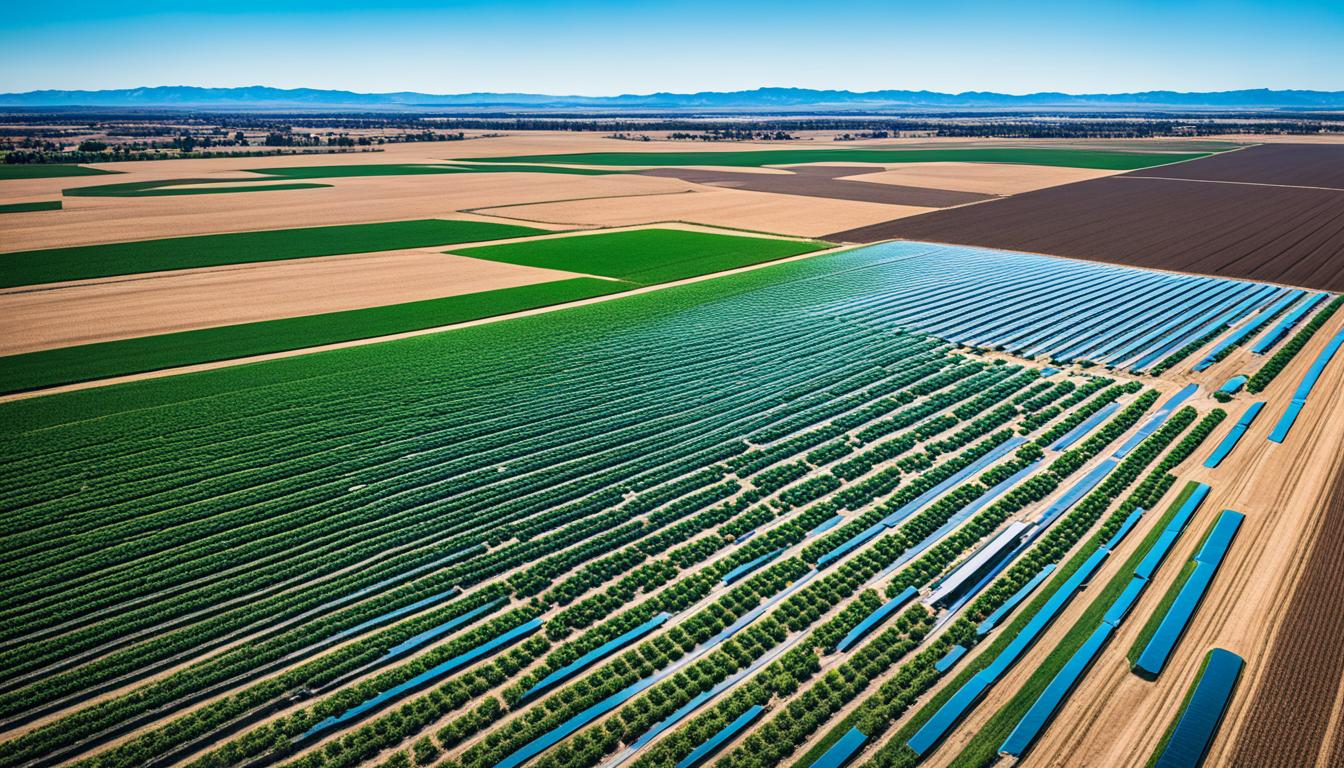
Did you know that autonomous farming technology can greatly boost how much we grow and do so efficiently? This amazing leap lets farmers concentrate on other vital tasks while cutting the time they spend on farming. Thanks to tech like precision agriculture, AI, IoT, and data analytics, farming now can use sustainable methods to keep up with our global food needs.
James Ferguson from DLL points out how crucial it is to use new tech in farming to face labour problems and make our food safer. This new way of farming not only takes over work that was done by hand but also makes farming better. It means we can get more from the land while using less.
Digitalisation is changing farming for the better. It’s moving us towards more efficient, modern methods. As the world’s population heads towards 9.7 billion by 2050, we must find ways to produce more food. We need up to 70% more farm output. To achieve this, we’re turning to smart farming technology.
Farmers today are dealing with a big issue – not enough workers. This affects 55% of them. The use of robotic technology is offering some solutions. Take, for example, strawberry farms. Automated harvesting systems can do the work of up to 30 people on a 25-acre farm. This not only helps with worker shortages but also boosts farm output.
The power of data and technology is clear in agriculture. Big Data allows farmers to make smarter choices. It can lead to big reductions in pesticide use. For example, automated weeding can cut down pesticide use by 90%. This is good for the planet. Plus, it saves water and energy, which is great for the environment.
Even with all these benefits, getting farmers to use digital tools can be tough. According to the U.S. Department of Agriculture, many are held back by high costs and complexity. Yet, precision tools from companies like John Deere are making a big impact on farming worldwide. By 2022, they have already reached 330 million acres.
Companies such as DLL are helping with this shift. They offer finance solutions for buying top-notch tech. But it’s not just about selling gadgets. Solutions need to solve real problems on the farm. This approach, along with better integration of new tech, is key. It can help improve farming, keeping food plentiful and reducing harm to our planet.
| Challenges | Statistics | Solutions |
|---|---|---|
| Global Population Growth | 9.7 billion by 2050 | Increased agricultural production by 70% |
| Labor Shortages | 55% of farmers affected | Adoption of robotics technology |
| Environmental Impact | 50% of farm costs are labour-related | Automated systems for energy and water conservation |
| Technology Adoption | No digital tech >80% adoption | Finance solutions and integrated approaches |
Autonomous farming equipment is changing the way we farm. It uses advanced tech to boost efficiency and productivity. This leads to lower labour costs and better crop outcomes.
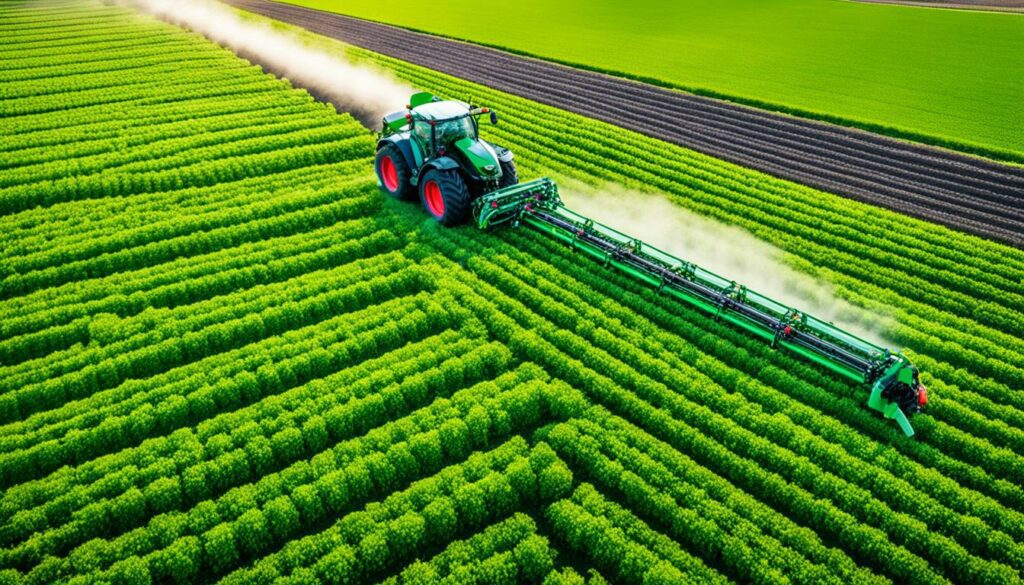
Automated farming is the future of efficient farming. It includes self-driving tractors with high-tech features like GPS, cameras, and sensors. These tools do more than just automate tasks. They make farming more accurate, fast, and less prone to mistakes.
Farms are saving money with autonomous vehicles. These machines keep production steady, even when there aren’t enough workers. They also work longer hours without much oversight, saving on manual labour costs. It’s predicted that only a 1% increase in agricultural workers will happen from 2019 to 2029. This shows how important automation is becoming.
One big benefit of autonomous equipment is better crops. These tools use data to plant, water, and protect crops more efficiently. They also help farmers know more about soil and crop health. This means farmers can make better decisions to grow more and better produce.
| Statistic | Value |
|---|---|
| Tractor Market CAGR (2020-2025) | 4.59% |
| Expected Increase in Agricultural Workers (2019-2029) | 1% |
| Global Farmers Under the Age of 40 | Less than 10% |
| Unharvested Specialty Crops Annually | 10 Million Tons |
Artificial intelligence is changing agriculture by using big data for smart tools. These AI tools make farming more productive and eco-friendly. They are crucial because the world will have 10 billion people by 2050. AI in farming is needed more than ever to meet this food demand.
The AI in agriculture market is set to grow big. By 2028, it could be worth USD 4.7 billion. This shows how much we rely on AI to farm better and more efficiently.
AI can find and fix crop diseases very accurately. It can spot apple black rot with over 90% accuracy. It can also pinpoint insects like flies and bees. This is very helpful for protecting crops.
AI drones excel at spreading pesticides. They can aim at problem spots more precisely. This means less harm to the environment and better pest control. It also means using less pesticide, which is good for the planet.
AI and machine learning help look after livestock. For example, CattleEye tracks cow health from afar. It spots unusual behaviour and even when a cow gives birth. This makes farm animals healthier and farms more productive.
AI, with the help of IoT sensors, manage crops automatically. It improves watering to save water and farm more sustainably. This gives farmers up-to-the-minute info on their crops’ needs, like when they need more water or nutrients.
Predictive analytics are key in farming businesses. They analyse the market, predict prices, and help with planting and harvesting times. This smart advice makes farming more efficient and increases yields.
AI isn’t just for crops and pests. It checks soil health, keeps an eye on the weather, and advises on what fertilisers or pesticides to use. This makes farmers more efficient and their farms more profitable by using better software.
| AI Application | Benefit | Accuracy |
|---|---|---|
| Detecting Apple Black Rot | Disease Management | Over 90% |
| Identifying Insects | Pest Management | Over 90% |
| Monitoring Cattle Health | Livestock Management | – |
| Autonomous Irrigation Systems | Water Conservation | – |
| Predictive Analytics | Market Forecasting | – |
To sum up, AI is crucial for farming to be more efficient, precise, and eco-friendly. By using AI-powered tools and machine learning, agriculture can meet the needs of a growing population. It also helps cut waste and use resources better.
Technological innovation is pushing us towards a new future in agriculture. Robotic farming devices are leading this change. They are making farms more autonomous, solving common issues, and boosting productivity.

Various farming robots are available for different farm tasks. Here’s what’s out there:
These devices change how we farm, needing less help from people while getting work done better and quicker.
Robotic crop management uses high-tech solutions. These include GPS, machine learning, and data analysis. They help make farming decisions in real-time, aiming for the best crop health and yields.
| Application | Technologies Used | Benefits |
|---|---|---|
| Crop Health Evaluation | Drone Imaging, Sensors | Spot diseases early, manage nutrients precisely |
| Soil Analysis | Robotic Sensors, Data Analytics | Better soil health, smarter water use |
| Targeted Pesticide Spraying | UAVs, Data Mapping | Less chemicals, better for the environment |
| Harvesting | Automation, Machine Learning | Faster harvest, less work needed |
Using these high-tech tools in crop management increases how much we produce. It’s also better for the planet, offering a future where farms are more sustainable. This new way of farming is quickly becoming the norm, changing the agricultural industry for the better.
We’re stepping into a new chapter of farm innovation with self-driving tools. Autonomous tractors have changed how we farm, making things more efficient and safe. They use AI and machine learning to work precisely, helping farmers all around the world.
Top companies like John Deere and CNH Global are leading the way in creating self-driving tractors. The autonomous tractor field has grown quickly since 2016. John Deere’s tech is used in over 100 countries, proving their dedication.
Models such as the John Deere 8R 410 and CNH Industrial New Holland T7.315 show big strides. They have high horsepower and come with advanced sensing technology. Then there’s the Monarch Tractor MK-V, an electric model that’s affordable for many farmers.
The Fendt 1000 Vario can fit different farming needs with its power range. A Fendt 936 autonomous tractor in Australia proves how well these innovations work.
Sprayers and seeders that can work on their own are changing farming, too. They apply pesticides and fertilisers very precisely. This cuts waste and helps the environment.
These machines can work day and night, making farms more productive. Smart seeding tools scatter seeds evenly for the best possible crop.
These tools make farming more efficient, lower costs, and improve productivity. But, there are challenges to overcome, like the large upfront cost and learning how to use the new tech. Still, the good they do for the environment and worker safety makes them very valuable for modern farming.
| Autonomous Tractor | Horsepower | Price Range | Notable Features |
|---|---|---|---|
| John Deere 8R 410 | 177-405 HP | $500,000-$800,000 | Global autonomy with AI advancements |
| CNH Industrial New Holland T7.315 | Various (lidar & radar) | Not specified | Lidar and radar sensors |
| Fendt 1000 Vario | 112-517 HP | Not specified | High capacity and advanced autonomy |
| Monarch Tractor MK-V | 250 HP | $50,000 | Battery-powered with AI capabilities |
Precision agriculture is growing fast, with autonomous tractors at the forefront. These tractors work for long hours without human input, cutting labour costs and boosting farm outputs.
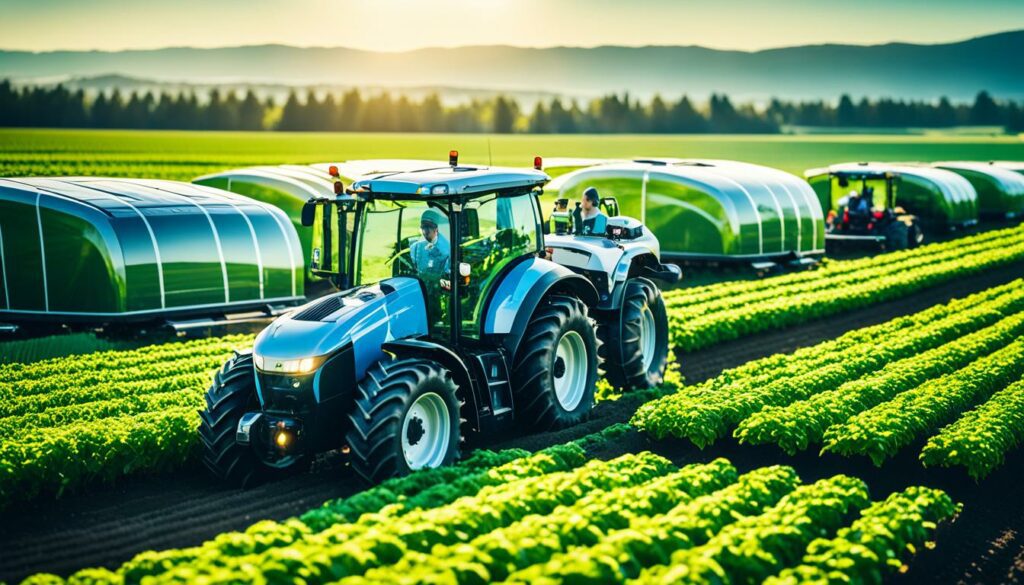
GPS and advanced data analysis are key in making farms smarter. Tools like autonomous tractors from Bluewhite move precisely and work almost on their own. This saves on water, fertiliser, and pesticides, supporting sustainable farming.
Adding to this, precision farming boosts output by placing water and nutrients exactly where plants need them. These smart tractors spot diseases early, helping to prevent crop losses.
Smart farming tackles issues with labour, enhances efficiency, and saves time. It aims to produce more while using fewer resources, essential for feeding a growing global population.
Farmers can enjoy big discounts, up to 50%, on new precision farming gear. This aims to push the use of high-tech tools that increase farms’ productivity, eco-friendliness, and profits.
In the end, with the help of technology like autonomous tractors, precision agriculture is a game-changer for farming. It boosts productivity and optimises the use of resources, promising a brighter future for farmers.
| Benefits of Precision Agriculture | Details |
|---|---|
| Improved Productivity | Optimised use of water, fertilisers, and pesticides |
| Cost Efficiency | Significant reduction in labor costs |
| Environmental Sustainability | Minimises waste and reduces environmental impact |
| Advanced Detection | Early disease and pest infestation detection |
| Technology Offers | Up to 50% discount on new precision farming products |
Modern farming relies on smart agricultural equipment for better results. It uses precision sensors and advanced tools for monitoring. This tech makes farming more efficient and saves energy.
Precision sensors have changed how farmers watch their crops and soil. They give immediate feedback on soil moisture, nutrients, and crop conditions. Farmers now use this data for smarter choices on water and pesticides. This boosts yield, cuts waste, and supports sustainable farming.
Smart tools help farmers be more energy efficient. They let farmers use resources better, which cuts down on energy use. This is critical due to high costs and environmental issues. Better resource use means saving money and helping the planet.
The farming industry must evolve with smart technology. This change makes farming more efficient. It also helps save resources and creates a healthier farming future.
AI in farming is changing the game with smart tech. It’s expected to feed a population of 10 billion by 2050. This pushes agriculture to use advanced methods to produce more but with less impact.
Now, AI tools for farming are quickly becoming the norm. Their market is set to jump from USD 1.7 billion to USD 4.7 billion by 2028. This big leap shows just how essential AI is for future farming. It helps farmers do more with less, saving resources and boosting their crops.
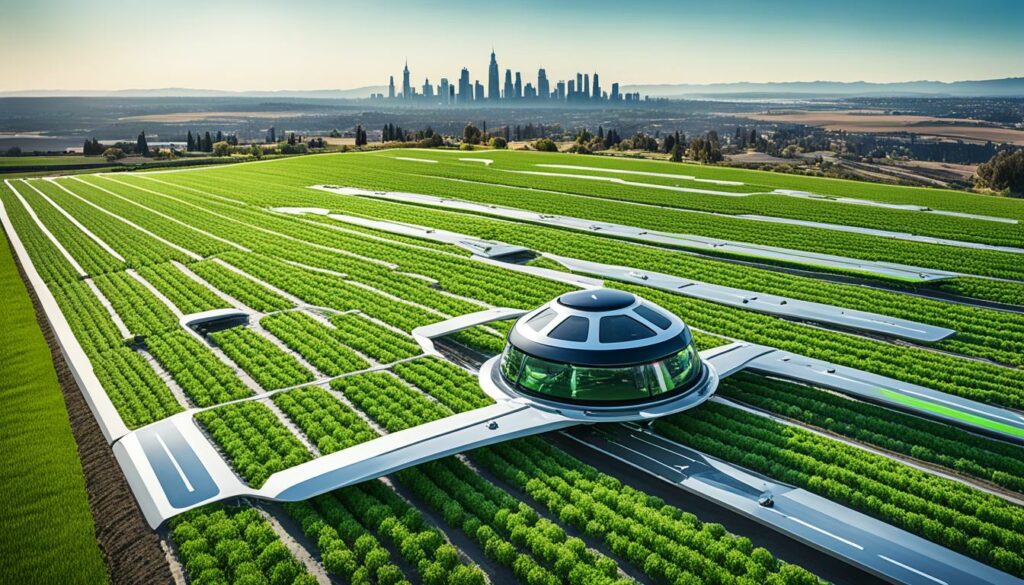
New AI is changing how we farm. Think driverless tractors, smart watering systems, drones, and robot harvesters. Amidst these, AI is key in smart watering, spotting leaks, keeping crops and soil healthy, bug spotting, and estimating crop sizes.
There’s also intelligent mapping and predictive tech. These use data to plan better and guess yields accurately. So, farmers are getting smarter insights, making farming more accurate and efficient.
AI in farming is moving towards better use of data and blockchain. This helps make farming decisions that match market needs and future prices. It also means using resources better, which cuts waste and ups productivity.
Overall, AI in agriculture opens doors to better, more sustainable farming. It’s all about working smarter for a brighter farming future.
By 2050, our world will have 10 billion people. This makes using big data in farming vital for making plenty of safe food. The power to collect and understand farming data is changing how farmers work. This has led to smarter, data-focused farming.
Today, farming with big data means using smart, tech-savvy methods driven by things like AI, IoT, and machine learning.
To gather data, farmers use a lot of tools. They can fly drones with cameras over fields or put sensors in the ground to check on water and nutrients.
AI is becoming really good at spotting threats to crops, like apple black rot. It’s more than 90% accurate, and this type of work will only get more important as the AI in agriculture market grows from USD 1.7 billion in 2023 to USD 4.7 billion by 2028.
Real-time data insights help farmers improve their crops quickly. For instance, using AI to map crop yields can show where improvements are needed. This makes farming more efficient.
AI also assists in fighting plant pests and diseases. With over 90% accuracy, it can spot bugs like flies and bees. This knowledge helps farmers use pesticides better, making their crops healthier.
Looking ahead, understanding market trends early on can lead to planting and harvesting at the best times. This increases farm output and helps in managing resources better. Essentially, using big data in agriculture is vital for advanced farming and making sure we can keep growing food for the future.
| Technique | Application | Benefit |
|---|---|---|
| Drone Monitoring | Aerial imagery of crops | Identifies crop health and issues early |
| Soil Sensors | Monitor soil moisture and nutrients | Optimises irrigation and fertilisation |
| AI Technology | Pest and disease identification | Increases accuracy in applying treatments |
| Yield Mapping | Analyse crop patterns | Improves farming strategy efficiency |
Dealing with tech barriers in farming means tackling issues like high costs at the start and worries about job losses. But the perks of using smart farming are big. They lead to better efficiency and more work done. This is especially true for machines that do farming by themselves. They cut down on the need for people, saving money on hiring and training them.
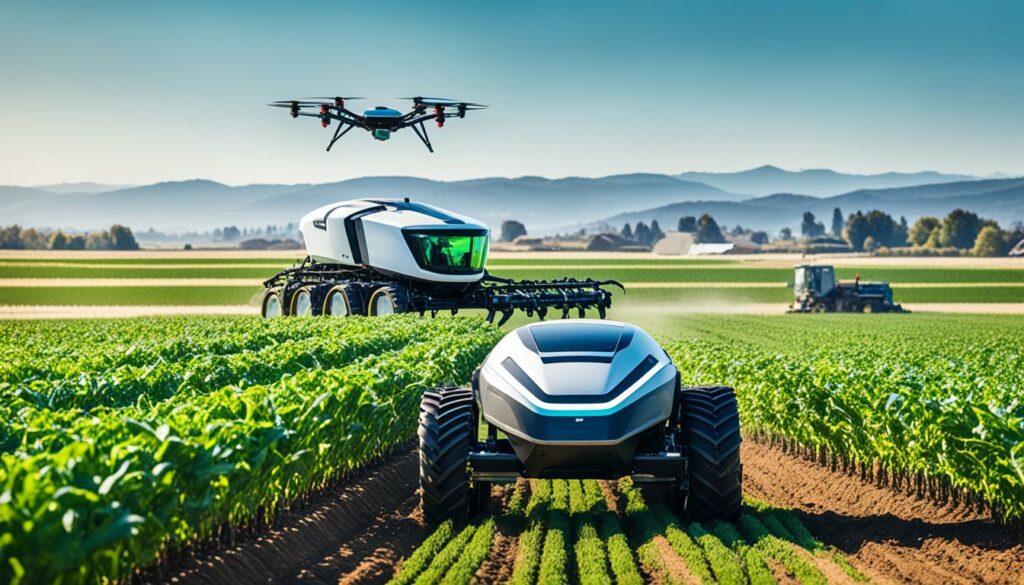
Smart farming also has bumps in the road when it comes to getting digital and the need for good internet in the countryside. Places like Ohio find it hard to use big machines since they don’t have good internet. John Fulton says fast upload speeds are key for these machines to work well.
In Europe, farmers are way ahead in adopting smart farming. This is because they have better support for their tech needs. It shows how important it is to have a good internet connection. The U.S. needs to make sure farmers everywhere can get the internet they need to use these new technologies.
It’s also important to make tech affordable. Companies like DLL are offering ways to help farmers get the tech that they need without spending too much. Teaching farmers how to use this tech through education and training is also key. It makes the new ways of farming more popular and easy to get into.
| Challenge | Solution | Impact |
|---|---|---|
| High costs of technology | Tailored financing solutions like those from DLL | Broader technology adoption |
| Perceived displacement of labour | Highlight efficiency and cost benefits | Increased acceptance |
| Limited rural broadband | Invest in rural broadband infrastructure | Enhanced connectivity for technology use |
| Knowledge gaps in technology use | Provide targeted education and training | Improved tech adoption |
Autonomous farming is changing how we grow food, making it more sustainable. It uses high-tech tools to farm smarter. This helps farmers use fewer resources, cut waste, and make farming kinder to the planet.
One big plus of autonomous farming is using less harmful chemicals. Self-driving tractors and other tech place pesticides and fertilizers exactly where they’re needed. This keeps the soil healthy and stops harmful chemicals going into water sources.
TYM was ahead of the game in 2013. They launched self-driving tractors in Korea in 2021. These tractors use advanced tech to cut down on farming’s chemical use. This makes agriculture more sustainable.
Autonomous farming also helps us save water. Normal farming can waste a lot of water. But with smart tools, farmers can use water more efficiently. They only water the crops that need it, saving a lot of water.
Thanks to this tech, farming doesn’t have to stop at night. It uses data to water crops at the perfect times. This means plants get just the right amount of water. So, they grow better and there’s less waste.
Autonomous farming is a big win for the environment. It uses less chemicals and water. These are key steps to making farming sustainable. As this tech gets better, farming’s future looks greener and more productive.
Autonomous farming equipment’s economic model needs a close look. We check its costs against the benefits in today’s farming. This study helps farmers see if investing in these tools is worth it.

Looking into the cost and benefit of smart gear is key to its assessment. Initially, buying these systems is expensive. But, the lower labour costs and the boost in what you can produce make up for this.
These tools, including robots and automated gear, reduce the need for human workers. They also help get better-quality results and more from your work. When you use these, you need less human help. This means more to be done and better living for the farmers.
Getting the money to buy advanced farm gear is very important. After all, these systems need a big first payment. Luckily, companies like DLL have ways to help. They offer plans that fit what farmers need, making buying these techs easier. This kind of help is vital in encouraging farm businesses to go this way. It makes shifting to autonomous farming possible and good for today’s farms.
| Categories | Description |
|---|---|
| Initial Investment | High initial expenditure on autonomous farming equipment. |
| Labour Cost Savings | Substantial decline in labour costs due to automation. |
| Productivity Gains | Enhanced efficiency and productivity with minimal labour input. |
| Quality Improvement | Improved quality of produce through optimal resource utilisation. |
| Financing Options | Access to financing options like those from DLL. |
The coming of autonomous livestock tools is a big step for modern farming. These tools use AI and machine learning to look after animals better, boost work, and spot diseases early. They are key to keeping up with the demand for food and making sure animals are well.
Farming has changed a lot since the first General Purpose Tractor in 1928. New technologies, like electric starts and rubber tires on tractors, have made farming better. Now, with autonomous livestock management, farmers can do more. They use smart equipment to work smarter without as much labour help.
Smart livestock gear has made farming with animals much more efficient. Systems that look at pictures and guides to help drive from 1994 and 2008 show how far we’ve come. These new tools make farming more productive. They help fight the lack of workers and add to a farm’s earnings. With the tractor market getting bigger, it’s clear that the future of farming will be full of new technology for doing things with livestock.
Autonomous farming equipment is changing farming as we know it. It uses AI and IoT to cut down on resources, which makes farming more precise and efficient. This helps farmers deal with fewer people working on the farm, makes food safer, and boosts the quality of what’s grown.
Digitalisation in farming means using smart technology and data to work better. Things like robotics and Big Data help farmers produce more, make more money, and rely less on manual work. This tech is making farming smarter and more profitable.
Autonomous farming gear offers loads of benefits. It makes farming operations smarter and more efficient by using robots that think and adjust themselves. This way, it cuts down on manual work, grows more crops of better quality, and uses resources well.
AI is very important in farming. It helps farmers make better decisions by crunching big amounts of data. This means more productive and sustainable farming, while also making things safer and easier with tools like self-driving tractors.
Robotic farming devices are truly changing how we farm. They can do things like planting, harvesting, and even sorting crops by themselves. This takes care of jobs like stopping pests and getting the harvest just right, making farming much more efficient.
Think of self-driving tractors by companies like Monarch Tractor as a cool example. These tractors use AI to work better and more safely. You’ve also got machines for spraying and planting seeds that do their job with high accuracy.
Precision agriculture lets farmers have super detailed control over their work with GPS and data. This fine control means using resources in the best way, which leads to better crops, saves the environment, and makes farming smart and profitable.
Smart farming tools have a lot of good points. They help save resources by being careful about how we use water, pesticides, and energy. This green way of farming is the future, making our food safe and the Earth healthier.
The future for AI in farming is looking bright. With more new tech and the use of blockchain, farming will be even more efficient and kind to the planet. This means better, faster decisions, and growth that’s good for the Earth.
Big Data is changing the game by giving farmers a lot of information to work with. Fast updates from drones and sensors mean making the best choices for farming. This high-tech farming method is smart, leading to more food and less waste.
Using smart farming tech has a few obstacles. High prices, concerns about jobs, and not knowing how best to use the technology are a few challenges. Overcoming these with more information and good ways to pay for the tech is key.
Autonomous farming is great for the planet. By being very exact with spraying and watering, it uses fewer chemicals and less water. This helps the environment and is the eco-friendly way forward for farming.
The costs and pay-offs of autonomous farming have to be carefully considered. Although starting can be expensive, it saves money in the long run and does more work. Companies that help with the costs, like DLL, are important for farmers.
Tools that look after animals by themselves are good for the animals and for farming. They keep the animals happy, help do tasks better, and spot diseases early. This makes farming animals a kinder and more efficient job.